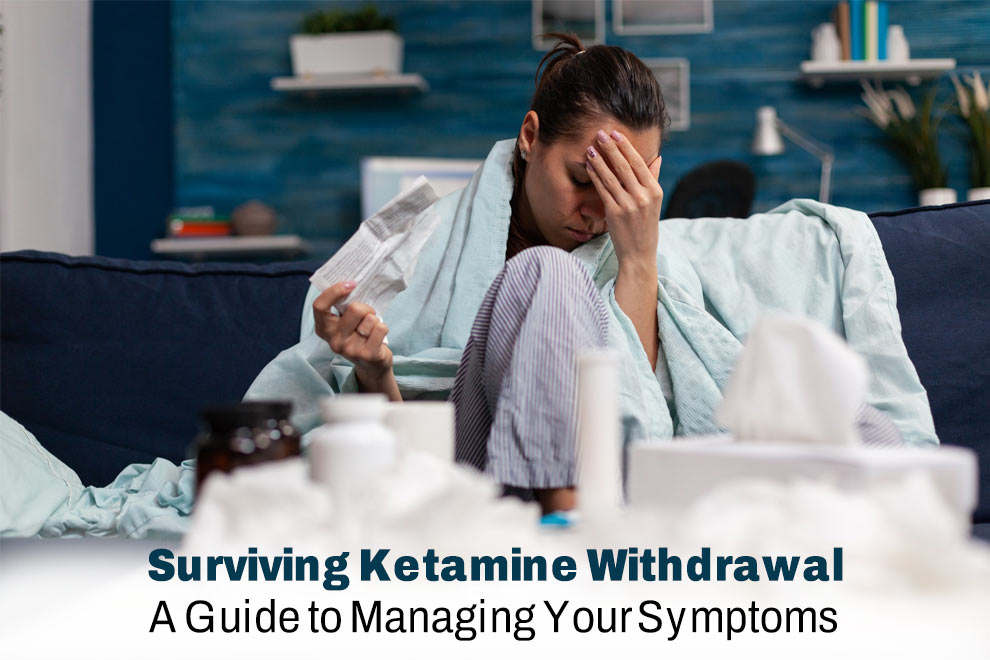Quitting ketamine can feel like a storm hitting hard. Your body and mind face tough changes right away. Many users deal with deep anxiety or a foggy head that lasts weeks. But you can handle this with the right steps.
Ketamine withdrawal hits more on the mental side than the body. It lacks the deadly shakes or seizures from other drugs. Still, the emotional rollercoaster demands real care. This guide walks you through spotting symptoms, getting medical help, and building habits for long-term healing. You’ll find tips to ease the pain and stay on track.
Identifying the Spectrum of Ketamine Withdrawal Symptoms
Ketamine withdrawal symptoms: Ketamine pulls users into a dream-like state. Stopping it brings back harsh reality. Symptoms vary by how much and how long you used.
Acute vs. Protracted Withdrawal Phases
In the first days, acute symptoms strike fast. You might feel restless or have trouble sleeping. These peak within 72 hours and fade in a week.
Protracted phases drag on longer. Think weeks or months of low mood and blank stares. Studies show up to 30% of users face this brain fog for over six months. Track your days in a journal to spot patterns.
One user shared how the first week brought sweats and jitters. By month two, it shifted to numb feelings that stole joy. Know the difference to plan your moves.
Psychological Manifestations
Anxiety can spike like a wave crashing over you. Depression sinks in deep, making simple tasks feel impossible. Cravings hit hard, pulling you back to old habits.
Flashbacks from “K-holes” replay in your mind. Paranoia creeps up, and moods swing wild. You question everything around you.
These mental hits stem from ketamine’s grip on brain chemicals. One study found 40% of quitters report intense mood shifts early on. Breathe through it—short deep breaths help ground you now.
Physical and Somatic Discomforts
Your body reacts too, though not as scary as with alcohol or opioids. Tremors shake your hands. Sweat pours out even in cool rooms.
Heart rate jumps, and your stomach churns. Some feel overall weakness or aches. Ketamine’s link to bladder issues might worsen here—stay hydrated to ease that.
Unlike heroin, no big risks like seizures lurk. But malaise drains your energy. A quick walk or warm bath often cuts the edge off these pains.
Establishing a Safe and Medically Supervised Detox Environment
Going cold turkey alone risks a rough ride. Pros guide you through the bumps. Start by reaching out for help right away.
The Critical Role of Professional Medical Assessment
See a doctor or addiction expert first. They check for hidden issues like anxiety that ketamine masked. A full exam spots any heart or bladder problems.
Blood tests rule out other causes for your symptoms. Co-occurring depression needs early treatment. One clinic reports better outcomes when users get screened within 24 hours of quitting.
Talk openly about your use history. This builds a plan tailored to you. Don’t skip this—it’s your safety net.
Managing Cravings Through Pharmacological Support
Cravings can feel like an itch you can’t scratch. Some meds help dull them. Antidepressants like SSRIs ease mood dips over time.
For anxiety, short-term benzos might calm the storm—but use them wisely under watch. No FDA-approved drug targets ketamine withdrawal yet. Doctors often pick options based on symptoms.
Chat with your doc about all feelings. Track cravings in a log: time, trigger, strength. This helps adjust your meds fast.
- List daily triggers, like stress or friends.
- Rate cravings from 1 to 10.
- Note what eases them, such as tea or a call to a buddy.
Creating a Structured Detox Setting
Inpatient care locks out temptations. You get 24/7 support in a calm space. It’s ideal if symptoms overwhelm you.
Outpatient works for milder cases. Attend sessions while staying home. Remove ketamine reminders—toss gear and avoid old spots.
Build a daily routine: wake at the same time, eat meals, rest. This rhythm fights chaos. One program saw 70% success with structured days.
Switch to IOP if inpatient ends. It keeps momentum without full isolation.
Navigating Protracted Psychological Symptoms: The Long Game
The early rush fades, but mental haze lingers. This phase tests your grit. Focus on small wins to rebuild your mind.
Addressing Cognitive Impairment and Brain Fog
Ketamine clouds memory and focus after long use. Tasks like reading feel fuzzy. Executive skills—planning or deciding—slip too.
Try mindfulness apps for five minutes daily. They sharpen attention bit by bit. Brain games like puzzles rebuild paths.
Eat omega-rich foods such as fish or nuts. Exercise boosts blood flow to the brain. Users report clearer thoughts after two weeks of steady effort.
One tip: Set phone reminders for short tasks. This fights the fog without overwhelm.
Treating Post-Acute Dysphoria and Anhedonia
Emotional flatness hits hard—nothing sparks joy anymore. It’s like colors faded from your world. This anhedonia stems from dopamine shifts.
Start small: Walk in nature or listen to old tunes. Reconnect with hobbies step by step. Therapy uncovers why pleasure vanished.
Journal grateful moments each night. It rewires your brain slowly. Studies link this to faster mood lifts in recovery.
Patience matters. Full feelings return with time and work.
Integrating Trauma-Informed Therapy Approaches
Many use ketamine to numb past pain. Quitting stirs up old wounds. Trauma therapy heals the root.
EMDR shakes loose stuck memories with eye movements. It cuts flashbacks quick. CPT reframes trauma thoughts logically.
Link between drug use and trauma runs deep—over 50% of addicts face it. Seek therapists trained in these. Group sessions share stories safely.
Start with one session a week. Track progress: less nightmares mean it’s working.
The Power of Supportive Networks and Lifestyle Adjustments
You don’t face this solo. People and habits lift you up. Lean in to what works.
Building and Utilizing a Robust Social Support System
Tell close ones what you need. “Check in daily, but no lectures.” They offer ears when cravings call.
Join online forums for ketamine quitters. Share wins and slips. Family meetings set clear boundaries.
One recovering user said a friend’s text stopped a relapse. Build your circle now—reach out today.
- Pick three trusted people.
- Share your quit date and goals.
- Schedule weekly catch-ups.
The Cornerstone of Physical Health: Sleep, Nutrition, and Hydration
Sleep repairs your brain overnight. Aim for seven hours in a dark room. Skip screens an hour before bed.
Fuel with veggies, proteins, and whole grains. They mend ketamine’s toll on organs. Drink water steadily—two liters daily—to protect your bladder.
Bladder pain from past use? Cranberry juice helps flush it. Track intake in an app. Better habits cut fatigue fast.
Engaging in Peer Support and Mutual Aid Groups
12-step meetings like NA fit dissociative drugs. Hear stories that match yours. Secular groups skip spiritual talk.
Weekly attends build bonds. Share your “K-hole” fears—they get it. One group cut relapse rates by 40% in trials.
Find local or virtual options. Step in nervous, leave stronger.
Conclusion: Commitment to Sustained Recovery
Ketamine withdrawal throws curveballs, but you can catch them. Seek pro help early to map your path. Spot acute pains and long mental slogs ahead.
Build routines, tap support, and heal trauma. Lifestyle tweaks like sleep and eats speed recovery. Stay in groups for ongoing strength.
Recovery demands daily choices. You’ve got the tools—use them. Reach out if you slip; fresh starts await. Your clearer life starts now.
Also Read: 5 Symptoms of Iron Deficiency in Children (And What To Do About It)











